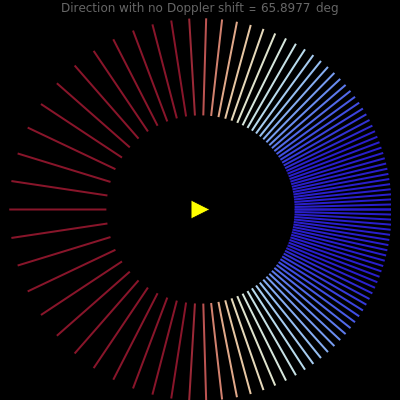Relativistic Aberration and Doppler Shift
Relativistic Aberration and Doppler Shift
Suppose a specific number of evenly distributed light rays is incident on an observer at rest. For a moving observer at the given location, with scaled velocity , these light rays appear to be tilted in the direction of motion (aberration), as indicated by the yellow triangle. As a result of the Doppler effect, light that comes from the direction of motion is blue-shifted, while light from the opposite direction is red-shifted.
β=v/c
Details
Details
A detailed discussion of relativistic aberration can be found in the standard literature of special relativity. Here, we use the aberration formula to transform between the stationary reference frame (unprimed coordinates) and the moving reference frame (primed coordinates). The Doppler factor is defined as , where is the wavelength of the emitted light from a source at rest with respect to , and is the wavelength measured by the moving observer. From the point of view of the moving observer, there will be no Doppler shift, , for .
cosϕ'=
β+cosϕ
1+βcosϕ
S
S'
D=γ(1-βcos(ϕ'))=
λ'
λ
λ
S
λ'
D=1
cosϕ'=1-
1
β
1
γ
External Links
External Links
Permanent Citation
Permanent Citation
Thomas Müller
"Relativistic Aberration and Doppler Shift"
http://demonstrations.wolfram.com/RelativisticAberrationAndDopplerShift/
Wolfram Demonstrations Project
Published: October 13, 2010
